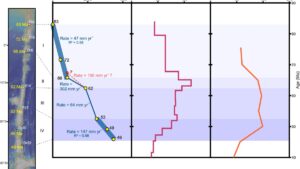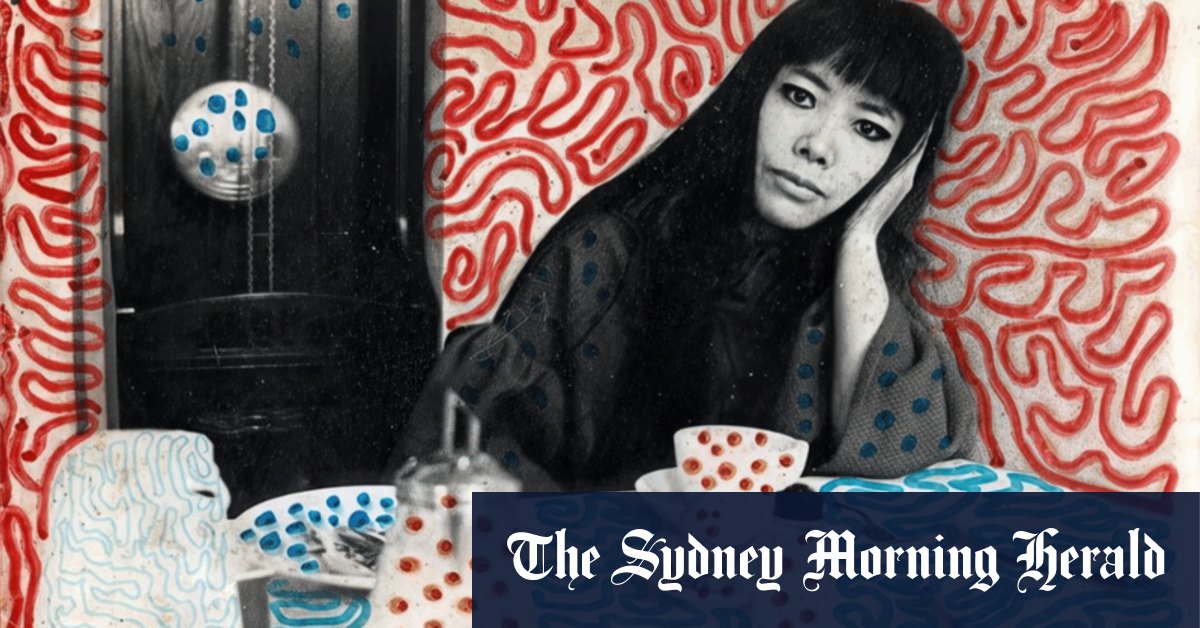
“No matter how I may suffer for my art, I will have no regrets.” Yayoi Kusama
The odds were stacked against Yayoi Kusama from the day she was born. Japan in 1929 was no place for a little girl with big dreams: stifling conservatism, wartime hardships and an oppressive family life defined by her father’s infidelities and her mother’s abusive behaviour were standing in her way.
By the age of 12, with her country at war, she was experiencing terrifying hallucinations in which she was consumed by objects around her. She found solace in art, drawing obsessively and daring to imagine that she might one day be a famous artist. But even her dreams seemed doomed. An Asian woman finding fame in the Euro-centric, male-dominated art world? It was laughable.
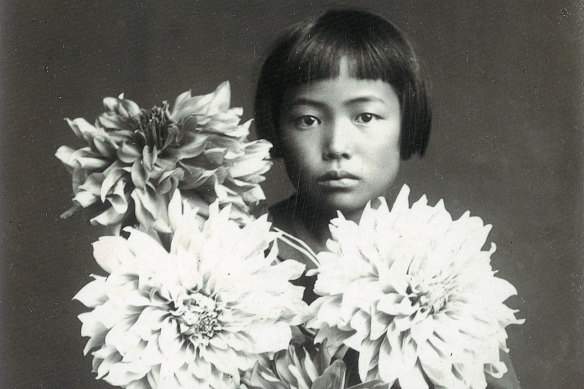
Portrait of Yayoi Kusama c.1939.Credit: Courtesy of the artist © Yayoi Kusama
The life story that one observer has described as a “ghastly and gorgeous struggle” must surely be one of the most remarkable in art history, involving more than eight decades of boundary-pushing creativity.
Aged 95, and still working inside the Tokyo psychiatric hospital that has been her home for almost 50 years, Kusama is one of the world’s most popular artists. Her name might draw an initial blank, but one or two words are enough to capture her impact. Dots? Pumpkins? Yes, that’s her.
When the largest exhibition of Kusama’s work ever staged in Australia opens at the NGV on December 15, it will reveal many things: the ability of art to chart a path through trauma; the power of personal vision to upend orthodox thinking; and the impact one diminutive but determined woman can make. Put simply, what we see in the brightly coloured paintings, collages, fashions, sculptures and immersive installations that will take over the entire ground floor of NGV International is hope.
It’s a message that her long-term gallerist, Hidenori Ota, embraces. Speaking through a translator at his gallery in the Tokyo suburb of Roppongi, Ota says Kusama’s story offers inspiration for a generation of young people confronting dark times.
“They can’t see the future, they can’t see hope,” he says. “I’m sure Kusama felt the same way as current teenagers are feeling. But she made it out as an international artist … hopefully this exhibition will represent hope that Australians, and especially young people, can get inspired from.”
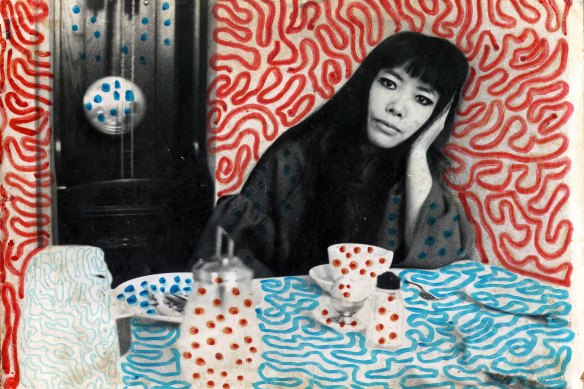
Pension (boarding house), The Hague, 1967. Photo print made by Harrie Verstappen and edited with Magic marker by Yayoi Kusama, 1967.Credit: © YAYOI KUSAMA / Harrie Verstappen
The exhibition – parts of which can already be seen in the NGV’s Federation Court, and across its famed water wall – traces Kusama’s journey as an artist and agitator. It begins with two of her earliest childhood drawings and follows her avant-garde awakening in New York in the late 1950s, her re-emergence on the world stage in the mid-1990s, and her current standing as a global art icon.
These days, collectors and museums pay eye-watering sums for her work and galleries compete to stage shows in which Instagrammers jostle for space inside her immersive installations. If critics occasionally sniff about her commercial collaborations – everything from pumpkin keyrings to Louis Vuitton handbags (one of which sold at auction for more than $230,000 in September) – there’s no denying her status as a beacon of joy.
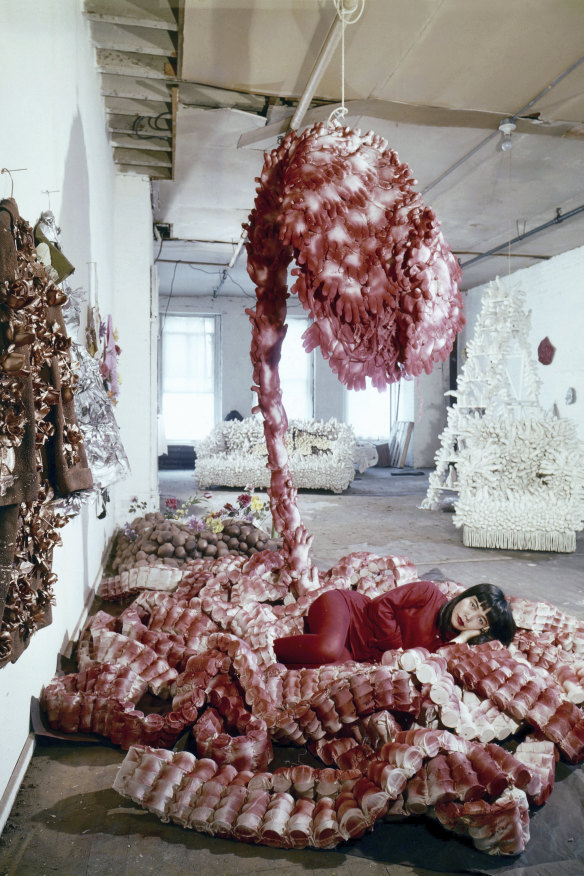
Yayoi Kusama in her New York studio, c. 1965, with her sculpture My Flower Bed, 1962.Credit: Peter Moore © Northwestern University
You only have to visit Japan’s so-called “art island” of Naoshima, home to a series of Kusama landmarks, to see the effect she has on people. Visitors from all corners of the globe gather on a pier, waiting to be photographed beside an iconic yellow and black pumpkin. One woman might be realising a life’s goal when she declares, “Yay! I made it.”
In the “valley gallery” of the nearby Benesse House Museum, people stand transfixed as hundreds of mirrored balls shimmy across a pond, creating an unexpected audio backdrop as they bump against each other. The balls, part of a work called Narcissus Garden, continue up a grassy mound and into a pavilion designed by acclaimed Japanese architect Tadao Ando. Among the tourists on Naoshima, there’s not a single person who isn’t smiling.
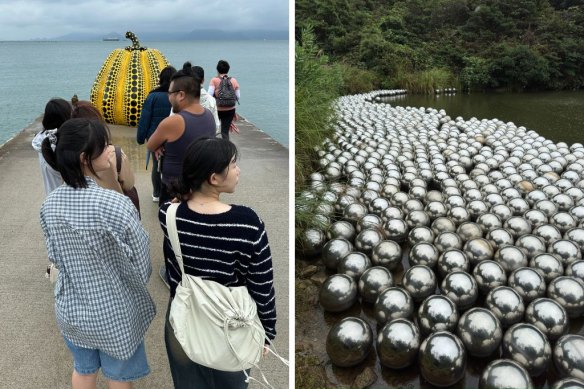
Yayoi Kusama landmarks draw art lovers on the Japanese island of Naoshima. Credit: Lindsay Cobb
We can expect similar scenes at the NGV, where another iteration of Narcissus Garden now sits behind the water wall, itself transformed by a pink skin covered with Kusama’s iconic black dots. In the nearby Federation Court, a massive, 11-legged Dancing Pumpkin, from 2020, has already become a magnet, while outside on St Kilda Road, the first of more than 60 trees to be wrapped in pink and white polka dots were unveiled this week.

Yayoi Kusama’s Dancing Pumpkin has already become a magnet for NGV visitors.Credit: Tobias Titz
As Wayne Crothers, the NGV’s senior curator of Asian art, observes: “Everyone loves Kusama.” Partly, he thinks, it’s because “people love to be placed in an outer-worldly realm”.
The most other-worldly of all the NGV displays will also be the newest. Infinity Mirrored Room–My Heart is Filled to the Brim with Sparkling Light, 2024, will have its world premiere in Melbourne. Crothers says that like other recent works, it sees Kusama “moving further and further out into the outer-terrestrial realms … into this infinite, ethereal world”. It’s one of 10 immersive spaces that will no doubt become the Instagram crowd’s playground of choice this summer.
During the five years he has spent working on the exhibition, Crothers has been drawn into what he calls “the greater social story” through which Kusama defied the odds.
“For an Asian woman to go to New York and start challenging all these establishment ideas in public spaces, I think it’s just an incredible social story,” he says. “There’s a celebration of freedom [and] her wanting to challenge the stuffy establishment of ideas.”
After landing in the creative hotbed that was New York in 1957, Kusama befriended fellow trailblazers including Andy Warhol, Joseph Cornell, Claes Oldenburg and Donald Judd. Images in the NGV show capture this heady period. We see Kusama painting dots onto the naked bodies of various acolytes who would assemble on the Brooklyn Bridge or Wall Street, or inside MoMA (which she dubbed “The Mausoleum of Modern Art”) to enact her headline-grabbing anti-war “happenings”.
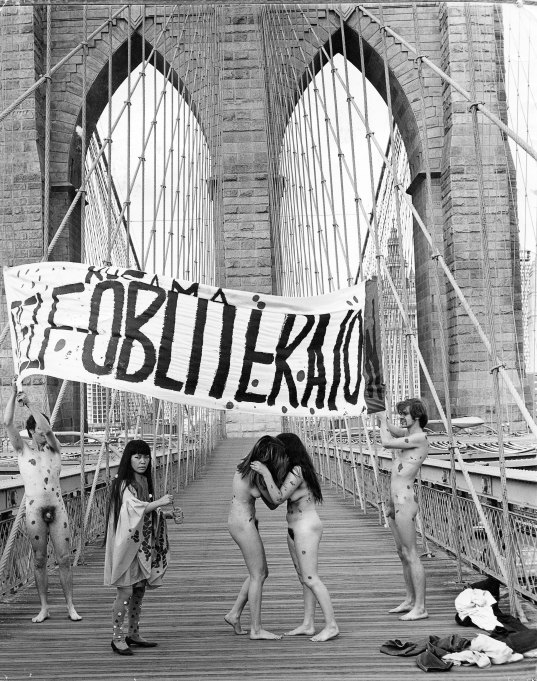
Yayoi Kusama, anti-war happening, Brooklyn Bridge, 1968.
Almost as scandalous were the phallic “soft sculptures” with which she covered furniture, boats, clothing and shoes, or those “orgy dresses” with their revealing cut-out sections.
It’s in this section of the show that we also see early examples of the dot paintings that would come to define her oeuvre. Created out of a desire for self-obliteration, these works, in which both she and the viewer are consumed in a vision of infinity, were hailed by critics as groundbreaking. In her autobiography, Infinity Net, 2002, Kusama notes: “I was firmly in the advance guard – doing work that was decades ahead of its time.” Humility was never her thing.
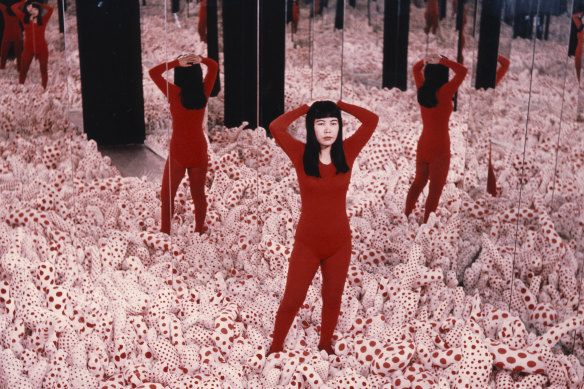
An installation view of Yayoi Kusama’s Infinity mirror room Phalli’s Field in 1965 at the Castellane Gallery, New York.Credit: Yayoi Kusama
While her autobiography acknowledges America as “the country that raised me”, the New York years took a toll on her fragile mental health. Two years after returning to Japan in 1973, she checked herself into the psychiatric facility where she has lived ever since. Though she continued producing art, it would be 20 years before she re-emerged on the world stage.
“She was totally outsider in the context of Japanese contemporary artists,” says Ota, who became her dealer in 1994, ignoring the advice of his peers. “Some of the big-name museum curators and directors ask me, ‘Ota-san, you are very unique but I suggest to you that you don’t touch Kusama’.”
Loading
Things began to shift following her solo showing at the 1993 Venice Biennale, the result of concerted campaigning by her long-time champion, Akira Tatehata. Tatehata, who is now the director of the Yayoi Kusama Museum in Tokyo, was a budding art curator in his early 20s when he first saw her work in the flesh at an exhibition in 1975.
Speaking via translator in an office lined with Kusama books and exhibition catalogues (there’s even a red and white spotted dress hanging from a shelving unit), he remembers the impact the show had on him.
“It was so fantastic and mysterious and beautiful,” he says. “I was shocked.”
He came away certain that Kusama was a genius, though convincing others would take time. Years later, when he was appointed as commissioner for Japan’s Venice Biennale pavilion, “a lot of people in the organisation were scared of doing her show because of her reputation”.
But it was the biennale that became her gateway to international acclaim. Major galleries, including the Pompidou in Paris, MoMA, and London’s Tate Museum came knocking, and the rest of the world eventually followed.
“She always said, ‘I’m going to cover the world with my dots’,” says Tatehata. “She wants to continue doing that. Even collaborating with brands gives the public access to her work, for people to say, ‘Oh, that’s Kusama’.”
He uses the term “salvation in obsession” to explain Kusama’s broad appeal; drawing on her own traumas and obsessions, he says, makes her work relatable.
“Once you show the obsession – with dot paintings, or repetitional paintings – that gives people a key to relate to her because that’s a very scary thing to show … if that other person has trauma, or obsession, or difficulties, they can come back to her and say, I can relate to you. So obsession actually creates the communicating platform for people.”
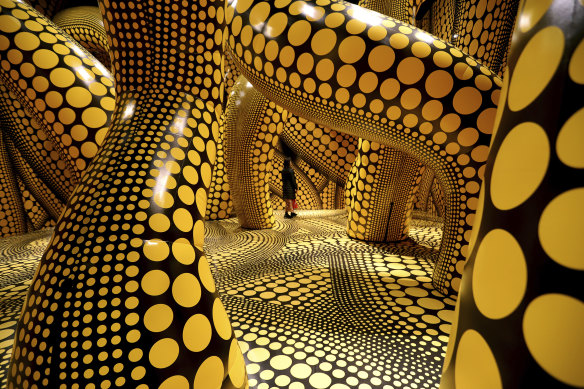
The Hope of the Polka Dots Buried in Infinity Will Eternally Cover the Universe 2019 at Kusama’s solo exhibition, Yayoi Kusama: All About Love Speaks Forever at Fosun Foundation, Shanghai. Courtesy of Ota Fine Arts.Credit: © Yayoi Kusama
For Ota, her appeal also lies in the way she can convey light and darkness within a single work. “Both sides you can actually feel by looking at her artwork,” he says. “There is a light side, but there’s also depth. It’s complex and interesting. That’s why it makes sense that some people who don’t like art can actually relate to her.”
Kusama no longer does interviews, but when I ask Ota what she might say to the people who will no doubt flock to the NGV show, he is certain that she would talk about hope.
“She’s looking forward to this exhibition,” he says. “She knows that there are a lot of fans there. Australia has hope, has a future.”
And for a glorious, dot-covered time this summer, we will also have Kusama.
An artistic odyssey
Daisuke Miyatsu was a university student when he first encountered Yayoi Kusama. Standing before “a very huge painting” of a white net against a white background, he felt like Stanley Kubrick’s Dr Dave Bowman, plunged into a trippy, colour-drenched wormhole in the Stargate scene from 2001: A Space Odyssey.
“I felt a very similar feeling,” he tells me, when we meet at a cafe inside Tokyo’s Imperial Hotel. “I didn’t know if I stood at the front of the painting or if I was in a different world … I had never felt such a special experience. ‘Oh wow,’ I thought, ‘she is an amazing artist’.”
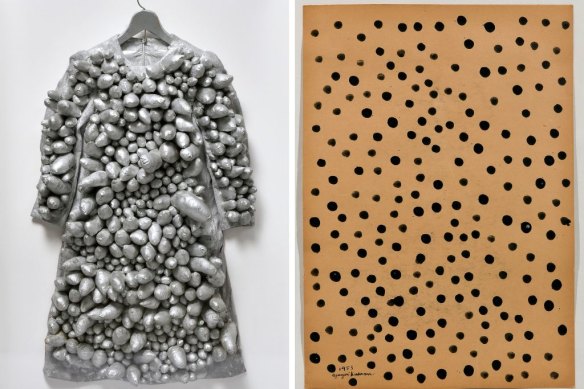
From left, Silver Dress, 1976, and Infinity Dots, 1953, are two of nine Kusama works in the NGV show owned by Daisuke Miyatsu.
Years later, he had the chance to buy a work by the woman who had captivated him as a young man. Working at an advertising agency during Japan’s prosperous 1990s, he and his friends were earning substantial bonuses. “Someone got an apartment in Tokyo, someone got a sports car, someone got a luxury watch … I was not interested in such a kind of luxury shopping. But I loved art very much so I tried to get one art piece, only for me, like a private collection … When I saw [Infinity Dots, 1953], I fell in love.”
It was some time before he could afford the $US6000 asking price, but he was never going to stop at one. When a larger work from 1965 came up for sale, he took a second job on a hotel night desk to help pay for it.
“I worked very hard and I was very tired for three to four years,” he recalls.
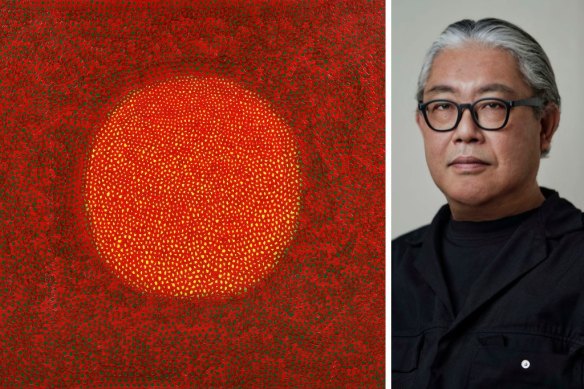
Daisuke Miyatsu took a second job to buy Yayoi Kusama’s Infinity Net, 1965 (detail pictured).Credit: Photo: Tadayuki Minamoto
Eventually, though they told him he was “crazy”, his mother and grandmother agreed to lend him the remaining $US20,000 he needed to buy Infinity Net, 1965, a blaze of red and orange dots with a central, sun-like ball. These two early purchases are among nine works he is lending to the NGV show. There’s also Silver Dress, 1976, covered in soft phallic shapes, a classic pumpkin canvas from 1981, and a 1975 collage that, as the title suggests, sends the viewer Soaring into Space.
Today, Miyatsu’s collection stretches to more than 500 works and he is yet to sell a single one.
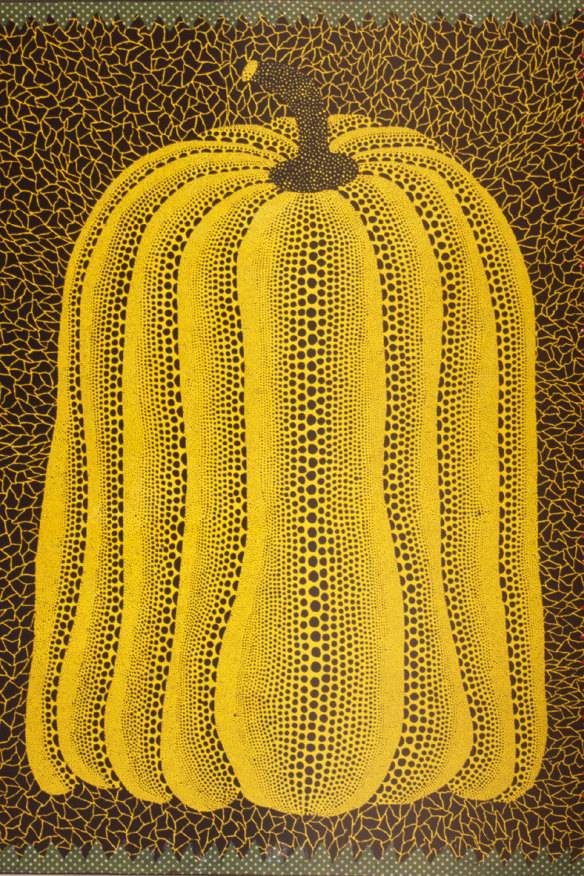
Yayoi Kusama, Pumpkin, 1981 (detail). Collection of Daisuke MiyatsuCredit: © Yayoi Kusama
“For 15 years, I collected Kusama but the price of her works was getting very expensive so finally I cannot catch up,” he says. “So I changed to collecting contemporary artists.
“Every artwork has memory with the artist, with curator, with my life. I faced some big financial problems – the company I worked for went bankrupt but I kept my collection because it’s a very big piece of my life, and my family and my friends. It’s very special.”
Remarkably, in a country where body art remains taboo, his collection now includes seven works that are tattooed across his back, designed for him by artists including Britain’s Ryan Gander. Though Miyatsu had worried about the pain, he now takes comfort in always having his art with him.
“When I [die], I will probably be away from my wife and my [art] so I want to leave with some of my collection,” he says. “I don’t need a fast car, I don’t need a Rolex. I don’t need a huge house. But I need art. Art is everything for me. Art is like my religion, I think. Very simple. Art and wife. Enough.”
Yayoi Kusama opens at NGV International on December 15.
Lindy Percival travelled to Japan with the assistance of the National Gallery of Victoria.


